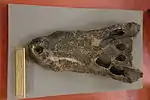Diplocynodon
Diplocynodon is an extinct genus of alligatoroid that lived during the Paleocene to middle Miocene in Europe. It looked very similar to the modern caiman in that it was small and had bony armour scutes covering its neck, back, belly, and tail. The longest Diplocynodon recovered was 4 feet in length and probably fed on small fish, frogs, and took insects when young.
| Diplocynodon | |
|---|---|
 | |
| Diplocynodon ratelii | |
| Scientific classification | |
| Kingdom: | Animalia |
| Phylum: | Chordata |
| Class: | Reptilia |
| Order: | Crocodilia |
| Subfamily: | †Diplocynodontinae |
| Genus: | †Diplocynodon Pomel, 1847 |
| Species | |
| Synonyms | |
| |
In the nineteenth century, D. steineri was named from Styria, Austria and D. styriacus was named from Austria and France. A third Austrian species, Enneodon ungeri, was placed in its own genus. The Austrian and French species of Diplocynodon were synonymized with E. ungeri in 2011, and because the name Diplocynodon has priority over Enneodon, the species is now called D. ungeri. [2]
Well preserved specimens have been found in the Messel Pit and the Geiseltal lignite deposit in Germany. Most articulated Diplocynodon specimens from these localities contain gastroliths. In the Eocene epoch, the German sites were either a swampy freshwater lake (Messel Pit) or a peat bog swamp (Geiseltal).
Species
| Species | |||||
|---|---|---|---|---|---|
| Species | Age | Location | Unit | Notes | Images |
|
D. dalpiazi |
Late Rupelian |
  Skull of D. hantoniensis  Diplocynodon cf. ratelii | |||
|
D. darwini |
All specimens are from Messel pit of Germany. Synonyms are: D. ebertsi and D. hallense. | ||||
|
D. elavericus[3] |
Middle Priabonian |
All specimens came from Allier, Massif Central of France. | |||
|
D. gervaisi |
Earliest Rupelian |
Ronzon |
Synonyms are: Saurocainus gervaisi. | ||
|
D. hantoniensis |
Early Priabonian |
All specimens came from Hordwell, southern England. D. cf. hantoniensis is known from the Oligocene of Dordogne, France. | |||
|
D. muelleri[4] |
Middle Rupelian |
El Talladell |
More than 100 are known, all from Lleida Province, Catalonia. Synonyms are: Hispanochampsa muelleri, D. guerini and D. marini. | ||
|
D. ratelii |
|
D. ratelii is the type species of Diplocynodon. Most of the specimens came from Allier, Massif Central of France. Synonyms are: D. gracile. | |||
|
D. tormis |
Late Bartonian |
||||
|
D. ungeri[2] |
Middle Miocene |
Synonyms are: Enneodon ungeri, D. steineri, and D. styriacus (see text). | |||
*Locality and/or horizon of the type specimen.
Phylogeny
Cladogram based on Martin, 2010:[3]
| Alligatoroidea |
| ||||||||||||||||||||||||||||||||||||||||||||||||
References
- Massimo Delfino and Thierry Smith (2012). "Reappraisal of the morphology and phylogenetic relationships of the middle Eocene alligatoroid Diplocynodon deponiae (Frey, Laemmert, and Riess, 1987) based on a three-dimensional specimen". Journal of Vertebrate Paleontology. 32 (6): 1358–1369. doi:10.1080/02724634.2012.699484.CS1 maint: uses authors parameter (link)
- Jeremy E. Martin and Martin Gross (2011). "Taxonomic clarification of Diplocynodon Pomel, 1847 (Crocodilia) from the Miocene of Styria, Austria". Neues Jahrbuch für Geologie und Paläontologie - Abhandlungen. 261 (2): 177–193. doi:10.1127/0077-7749/2011/0159.CS1 maint: uses authors parameter (link)
- Jeremy E. Martin (2010). "A new species of Diplocynodon (Crocodylia, Alligatoroidea) from the Late Eocene of the Massif Central, France, and the evolution of the genus in the climatic context of the Late Palaeogene". Geological Magazine. 147 (4): 596–610. doi:10.1017/S0016756809990161.CS1 maint: uses authors parameter (link)
- Paolo Pirasa and Angela D. Buscalionib (2006). "Diplocynodon muelleri comb. nov., an Oligocene diplocynodontine alligatoroid from Catalonia (Ebro Basin, Lleida Province, Spain)". Journal of Vertebrate Paleontology. 26 (3): 608–620. doi:10.1671/0272-4634(2006)26[608:DMCNAO]2.0.CO;2.CS1 maint: uses authors parameter (link)
- Fossils (Smithsonian Handbooks) by David Ward (Page 243)